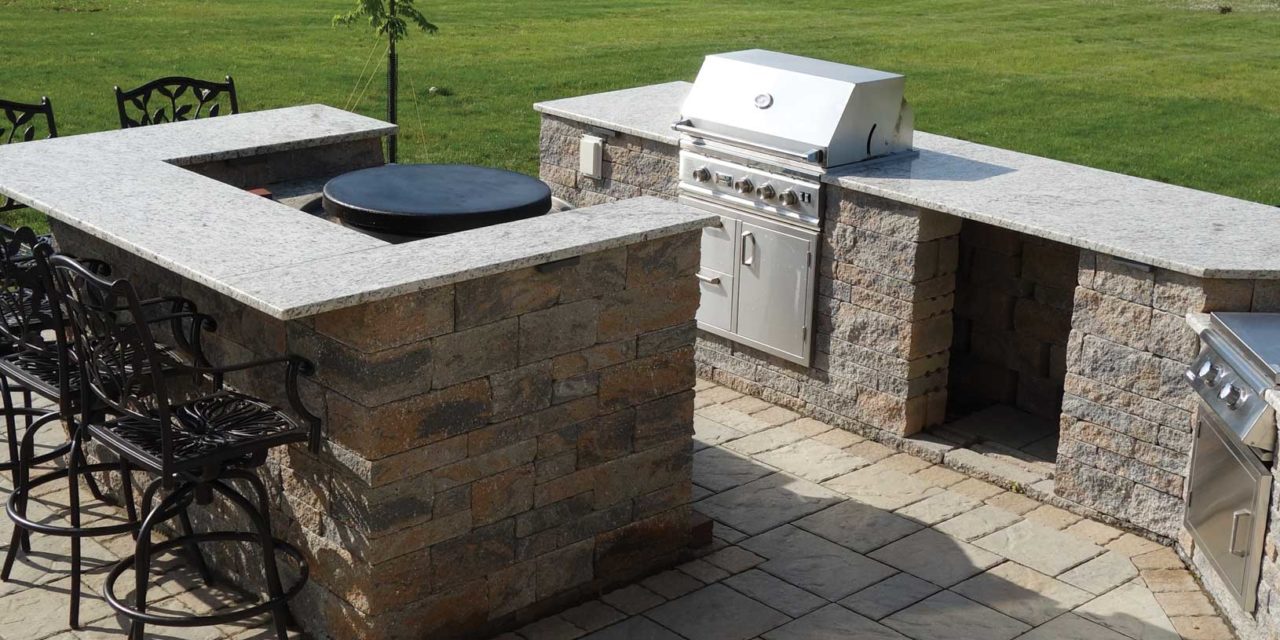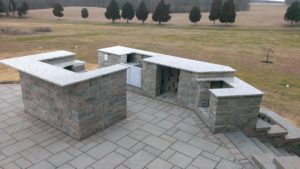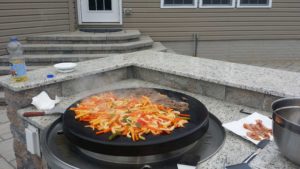by Linda L. Esterson
When Steve and Eva Dicocco built their house two years ago, they had visions of more than the dwelling.
Their 1.6 acre lot backs to farmland owned by the family of John Carroll, the first American Catholic bishop and one of four signers of the Declaration of Independence.
From his kitchen’s 10-foot picture window, Steve Dicocco has a full view of the beautiful flowing backyard that they had “fallen in love with.” From the outset, they had something elaborate in mind: an outdoor kitchen. Their requirements – not something “cookie cutter,” but something designed specifically for their family.
“With the breathtaking view, we wanted to capitalize on that,” says Steve Dicocco. “We built the whole house with the outside in mind. We love to entertain; we love to have friends over.”
After some investigating, Dicocco connected with Tom Powel of Outdoor Additions and Carl Larkin of Fireworks, and together they designed a beautiful two-tier outdoor entertainment area to host gatherings or just enjoy as a family.
The lower tier comprises a seating area for 10 with an outdoor couch and chairs, and includes a table with a built-in fire pit. The upper patio with an outdoor dining table and chairs seats eight, not including the bar top that accommodates five.
But what Dicocco is most proud of is the rest of the space – an elaborate outdoor kitchen on the top tier, complete with an outdoor grill with built-in rotisserie and power burner, and an island with an integrated round hibachi grill. He’s fried a turkey on the power burner, grilled a chicken on the rotisserie and baked a pizza on the hibachi. He also has an electric smoker he can wheel over from the garage, if needed.
“Anything you cook inside, you can cook outside,” he says. “In the summer, I cook outside three to four days a week.”
According to Powel, a variety of definitions exist for outdoor kitchen. It can represent simply a portable grill bumped against a stone countertop or it can mean a built-in grill with bar seating, a side burner, refrigerator, and sink. Almost any appliance can be put outdoors and some customers, he says, run plumbing outdoors and add a dishwasher. Building an outdoor kitchen can range from $1,500 to $20,000 and more, he says, exclusive of the grill and depends on the amenities and scope of the project. If a patio and seating are included the price is higher. Brian Moran, owner of Land Art, Inc. in Sykesville, builds outdoor kitchens from $5,000 to $50,000 depending on the elements included. On the high end is a built-in grill with a custom-built bar, cabinetry, granite countertops and outdoor lighting. Choosing stackable concrete blocks instead lowers the cost as does purchasing a premade, faux stone box with a cutout for the grill, Moran says.
Department stores like Home Depot and Lowes, for instance, carry grills and accessories for building independent islands that hold the grill. Depending on materials and accessories, pricing goes up to $10,000. Lowes even provides an online tutorial to build a “do-it-yourself” stacked stone and wood structure for under $1,000, grill excluded.
“An outdoor kitchen includes something to cook on and the countertop space can be elaborate granite or stone or a built-in island,” says Carl Larkin, president of Fireworks, seller of grills and equipment for indoor and outdoor kitchens. “Or it could be a picnic table, card table or tree stump.”
Portable grills available at retailers like Home Depot, Lowes and Wal-Mart come with side shelving. But most people, Larkin says, need more than a shelf, especially if the grill is located further from the house and the indoor kitchen.
For more elaborate and polished outdoor kitchens, homeowners choose to allow contractors to do the construction, and end up with a living space often as nice as the one indoors.
Most outdoor kitchens incorporate a built-in gas grill, which the homeowners select prior to meeting with the contractor to design the outdoor space. The first consideration is use, which determines how far away from the indoor kitchen the outdoor grill will be located. If outside a sliding door and down one step, then there is not a need for a countertop or refrigerator, Powel says. Or, if there’s a pool down several flights of stairs, then more amenities would be required like sink, refrigerator, icemaker, lighting, storage and an area for prep work, Larkin adds.
“I suggest investing in a grill that will last,” says Powel, who builds around the grill’s dimensions, and advises against low-cost grills that will last just a season or two and provide difficulty in finding replacement parts down the road.
“The initial cost is higher, but the cost to maintain is practically non-existent,” echoes Larkin. “They are built so well and last so long.” The grills are also manufactured with even cooking systems that don’t have the hot and cold spots that lower cost models do.
Today’s grills include a variety of features and options that make them more versatile, says Jeff Gingco, hearth and grill specialist for Tevis Home in Hampstead.
In addition to the main burners, many have the capability for a separate rotisserie, used for many foods in addition to cooking a delicious chicken. Depending on the grill, the rotisserie either hangs over the grill or works with a separate burner on the back of the grill. The rotisserie has optional skewers, which connect to a wheel that is mounted on the rotisserie for making kabobs. This way, the meat doesn’t stick to the grill. Gingco suggests placing a drip pan underneath to catch the juices. There’s also a basket that connects onto the rotisserie for grilling anything from vegetables to chicken wings.
Another popular feature for all grills is a searing zone, Gingco adds. This enables searing of steaks and other meats, yielding black grill marks like at a restaurant. Searing is either accomplished with a “sizzle zone” that reaches 800-1000 degrees, or through a separate searing station on a separate burner that can reach 1,800 degrees.
“You can really cook a steak authentically,” Gingco adds. “It’s becoming more and more popular with the general public.”
After the grill, consider whether a side burner is desired. Will crabs be steamed outdoors? Will leftovers be heated there?
The next most common inclusion, Powel says, is the outdoor refrigerator, which stocks beverages for convenience.
Not as common is the outdoor sink, which requires plumbing and drainage, and attention during the winter when pipes can freeze.
Seating is also a priority as outdoor kitchens are usually built for entertaining, Powel notes.
“I always try to include bar seating around the grill because that’s where people will end up,” he says. “When people entertain outside, it revolves around what they are putting on the grill.”
Décor is also a consideration, as often homeowners choose a hard stone material for their retaining wall and interlocking concrete pavers or bluestone for the flooring. There are non-stone options as well, and choosing the design and materials is just as involved as making selections for inside the home.
The contractor isn’t the only professional involved in the project. Electricians and plumbers are often summoned to run wiring for rotisserie motors, blenders, outdoor heaters and lighting, as well as the gas needed for the grills and hibachis and water lines for the sinks, icemakers and sometimes refrigerators.
Outdoor kitchens, like the Dicoccos’s, are growing in popularity. According to a study released by the Hearth, Barbecue and Patio Association, 10 percent of grill owners have an outdoor kitchen, featuring primarily premium grills, furniture and lighting. Of these outdoor kitchen owners, 35 percent are likely to upgrade in the next three years. These upgrades include 67 percent planning to purchase new outdoor furniture; 46 percent planning to improve their deck/patio (and/or build a new one); 43 percent planning to improve their garden/landscaping; and 38 percent planning to purchase a new premium grill or smoker.
The outdoor kitchens also prove a valuable investment, explains Larkin, in business for 30 years. “It can be an enhancement to the home’s value or it could be a hindrance if you use inferior products that don’t work over time or become rusty.”
Moran, in business for 23 years out of Marriottsville, lately is building more curved bars and seating areas to allow guests to look at each other. He’s also entertaining requests for outdoor televisions and fireplaces as well as ceiling structures to cover the area from the rain and direct sunlight.
“We can make an outdoor room as far as you want to go,” he says.
Powel, a former dairy farmer who started construction work in 2005, is seeing an increase in requests for amenities on the outdoor patio like wood fire pizza ovens, gas griddles and fireplaces.
“Outdoor kitchens today are more inclusive,” he says. “There are definitely more choices and what’s driving those choices is demand. People are investing in more expensive outdoor kitchens and they will enjoy them for years.”
Dicocco concurs. “It’s been fantastic and we absolutely love it,” he says. “It’s such an amazing space. It feels like an extension of our house.”



